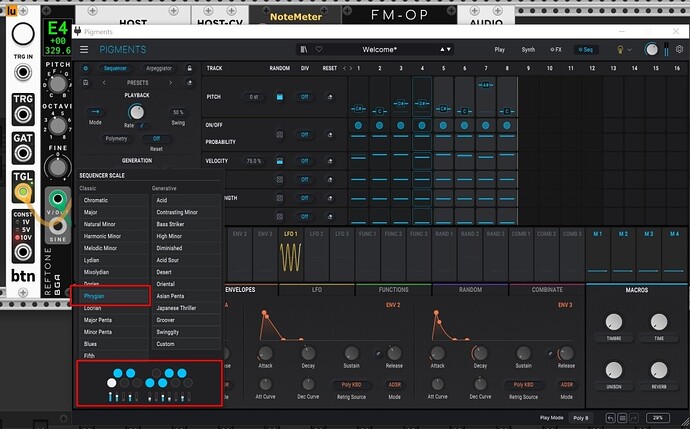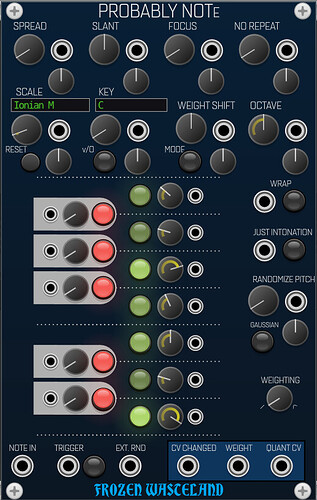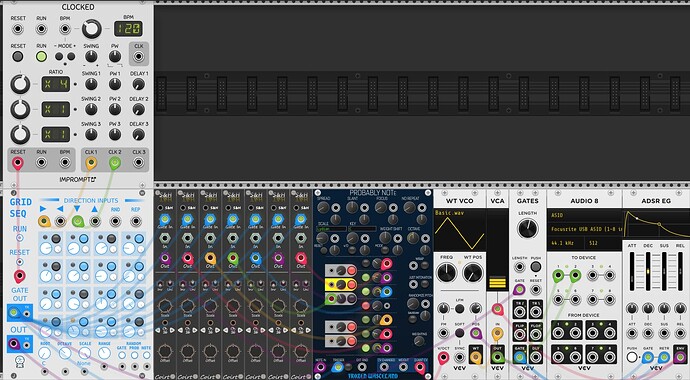My modules all have a correct Phrygian, and will generate the monies 2nd quite happily.
My mom showed me the modes on the piano, Ionian starts on C, Dorian on D etc.
Which implies that the piano keyboard was defined by the modes, which came first. The black keys are between each whole step in the diatonic scale.
It also follows that if you use modal scales, you have to imply the root in order for the listener to hear which mode you’re using. It also implies there are ambiguous note sequences where 2 different modes have common subsets of notes.
yes, as people above said - it’s hard to establish the root, and your ear keeps pulling you back to the relative major or the relative minor if you don’t establish the root well enough. I can tell you that when you are jamming with people and they are playing “altered” scales it can be really difficult to figure out what key people are playing in.
The ‘Regen’ function in the sequencer of the Arturia’s Pigments VST allows to set note probabilities. Can integrate via VCV Host and the Host-CV expander to extract the MIDI notes.
Would be really nice to have something similar in a sequencer module for VCV Rack.
The ‘Probably Note’ quantizer is a great workaround and probably can go a long way, too.
The ‘Regen’ function in the sequencer of the Arturia’s Pigments VST allows to set note probabilities.
Probably Note has per-note probability. I’ve never asked @almostEric where he got the weights for the notes in his mode presets. He’s put more time into understanding different tuning systems & quantizing than almost anyone, so I assume the weights don’t come out of nowhere.
It’s also cool to tweak the scale note probabilities, and because it’s @almostEric , you can CV control the note probabilities and come up with any amount of weird shifting tonal colors.
2024-03-08.vcv (12.9 KB)
This illustrates the effect of modulating the per scale-degree probability.
You don’t have to try this hard, because you can also modulate “Weight Shift” which also changes the probabilities.
Oh and also “Spread” controls ‘spreads’ the quantized note outputs from the closest note. And you can modulate that too.
This patch needs a one sample delay between the note trigger into the quantizer, so the weights change before the quantizer chooses a note.
Thanks for reminding me of the Frozen Wasteland Probably Note module. It has a wealth of scales for sequencing purposes. I’m not aware of any modules that could coherently form chords in each of these scales, but that is okay. Meander in the early days supported many of the Probably Note scales, but since I could never rationally create chords, I dropped these for the VCV Rack Meander and went pure modal diatonic,
I just mapped out all of the Probably Note Scale and Key CV input eigenvalues so I can sequence Probably Note Scale and Key
I’ll do the same with the Weights but the built in weights allow for a lot of interesting variations.
Harmony would for coherent chords in all the diatonic modes, yes?
I’m not aware of any modules that could coherently form chords in each of these scales
What I generally do is put a VCV Chords before Probably Note. That at least makes the chords add up harmonically. But my whole thing harmonically is making everything modal. ![]()
Yes.
So, in this patch when you CV sequence the “weight”, there is no way to tell what the resulting weight is other than by looking at the weight knob and estimating the weight?
Well you know what the modulation source is, so you can work out what the weight is from that. I’m not as careful or intentional as you are though, I just let it rip! ![]()
I think - and maybe @almostEric can confirm - if you modulate weight with 0-10v, and turn the knob all the way up, the CV input is the weight.
I’m not even that clear on what the weight knob does exactly because it’s a knob I twiddle by ear.
Thanks. The exact values do not matter except when I try to sequence parameter CV’s in a predictable manner. I should be able to estimate weights though as they are not as sensitive as compared to the Scale and Key parameters. BTW, I modified my BASICally scripts such that changing mode and root in Meander changes Probably Note Scale and Key to the same settings, much as I do with Squniktronix Harmony and a few other modules that Meander can plan well with. Of course these are modal scales only, but it is pretty neat, I think.
Thanks @Alphagem-O, I use Pigments too but haven’t tried the generative sequencer yet. I got distracted making guitar effects with the external input in v5. So much stuff to mess about with, so little time!
I think Pigments’ sequencer is a (more or less) hidden gem because in contrast to other synths with sequencer, the MIDI can be sent out and used by other plugins.
I actually haven’t used the external input of Pigments yet and would love to check out what you did. Interestingly, just the other day, I had fun trying the audio input of Cherry Audio’s semi-modular synth CA2600.
Hah! I just realized that there is the Frozen Wasteland Probably Note Chord Expander module. There is not too much specific detail in the manual, but, at least there is a manual.



